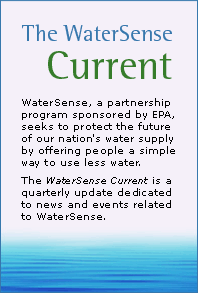The WaterSense Current Fall 2007
In This Issue IV, Fall 2007:
Our Latest Treat: A New WaterSense Faucet Spec
Soon there will be a water-efficient way to clean up your little ghouls, ghosts, and goblins after trick-or-treating. On October 1, 2007, EPA released its Lavatory Faucet Specification, a step that now allows manufacturers to apply to earn the WaterSense label for their high-efficiency faucets and faucet accessories, such as aerators.

Residential bathroom and kitchen faucets account for more than 15 percent of indoor residential water use in the United States—equivalent to more than 1.1 trillion gallons of water used each year. Most existing faucets, however, flow at rates that are much higher than what is actually necessary.
The new specification, which addresses private-use bathroom sink faucets and aerators (WaterSense will address kitchen faucets at a later date), paves the way for high-performing, water-efficient technology in the marketplace. The specification establishes a maximum flow rate of 1.5 gallons per minute (gpm), which is about 30 percent more efficient than the standard faucets sold now.
Installing WaterSense labeled faucets can reduce a household's water use by more than 500 gallons per year. Savings could be even greater for households replacing older faucets, which can flow at rates as high as 3 to 7 gpm.
Beyond water savings, these WaterSense labeled products will also help you save on your gas or electric bill. Using WaterSense labeled faucets or faucet accessories could save 70 kilowatt-hours of electricity used for heating water annually—that's enough electricity to power your hair dryer for about 8 minutes a day for a whole year.
By Halloween next year, you will be able to hand out WaterSense labeled aerators instead of mini candy bars. Now that's what we call a treat!
Learn more information about faucets and the final specification, and look for WaterSense labeled faucets and faucet accessories coming soon in 2008.
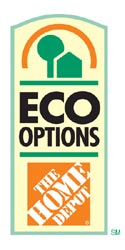
They Do It, We Help: The Home Depot Joins WaterSense
WaterSense is seeing orange—and we don't mean the pumpkins on your front porch. WaterSense is proud to announce that one of the world's largest home improvement specialty retailers, The Home Depot®, is the program's newest retail partner.
As a WaterSense partner, The Home Depot will bring WaterSense labeled
products to its customers as part of its corporate commitment to
environmental stewardship. The Home Depot recently introduced its
Eco
Options![]() program to identify products that have lower environmental impacts
than other products and to promote water conservation, sustainable
forestry, energy efficiency, healthy homes, and clean air. In its
Web site, The Home Depot recommends using high-efficiency toilets
and showerheads and provides tips for indoor and outdoor water conservation.
Already, The Home Depot is stocking WaterSense labeled high-efficiency
toilets in several retail markets.
program to identify products that have lower environmental impacts
than other products and to promote water conservation, sustainable
forestry, energy efficiency, healthy homes, and clean air. In its
Web site, The Home Depot recommends using high-efficiency toilets
and showerheads and provides tips for indoor and outdoor water conservation.
Already, The Home Depot is stocking WaterSense labeled high-efficiency
toilets in several retail markets.
With more than 2,200 stores around the world, The Home Depot has an impressive reach. WaterSense looks forward to working with The Home Depot to serve this growing segment of environmentally aware do-it-yourselfers.
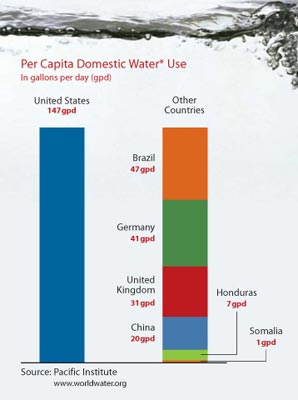
We Must Be Really Thirsty!
U.S. Consumes More Water Than Most
The average American uses more water each day than several people in many other countries combined. Though we're not the largest water user in the world (that dubious honor goes to Lithuania, which uses nearly 550 gallons per capita per day), as a nation we can do much better. Let WaterSense show you simple ways to save water.
*Note: Domestic water use includes the water we use commercially and industrially, as well as the 100 gallons per day we use residentially.
WaterSense Interactive
How do YOU save? Tell us your best water-saving tips, and read about our favorites in the next issue of the WaterSense Current.
Never Let a Toilet Run...
How do you stop a running toilet? WaterSense partner Denver Water showed all that it takes is an out-of-the-box water conservation campaign—and one fleet-footed security guard.
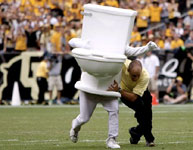
To help remind a stadium crowded with fans that running toilets waste water, Denver Water sent a man dressed in a toilet costume sprinting across the football field in the fourth quarter of a University of Colorado vs. Colorado State University game this September. The stunt was part of Denver Water's campaign to reduce the city's water use by 22 percent compared to consumption before the region's drought began in 2002.
For more information about the utility's impressive, innovative
outreach, visit Denver
Water's Use Only What You Need Web site ![]() .
.
Rocky Mountain Recap: Region 8 Hosts Administrator Johnson
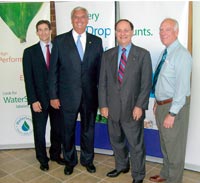
As part of a two-week nationwide "Water Infrastructure Tour," EPA Administrator Stephen Johnson visited Denver, Colorado, in August to focus on the sustainability of our nation's drinking-water and wastewater infrastructure. The Colorado visit included a tour of Denver Water's water recycling plant, which began operation in 2004.
Pictured above: Benjamin Grumbles, EPA Office of Water Assistant Administrator; Stephen Johnson, EPA Administrator; Jack W. Hoffbuhr, American Water Works Association Executive Director; and Kerrigan G. Clough, EPA Region 8 Deputy Regional Administrator.
"I don't know what's more remarkable—the technology the plant is using or the insight Denver Water has shown in building it," said Benjamin Grumbles, EPA's Assistant Administrator for Water, who also visited Denver. The tour also made stops in Michigan, New Jersey, Pennsylvania, Tennessee, and Texas.
Dolphins Make a Splash With Less Water:
Stadium Renovation Includes WaterSense Labeled Toilets
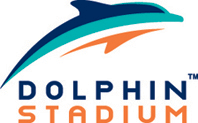
This year, the phrase "super bowl" has taken on a new meaning.
While the Miami Dolphins have been floundering a bit so far this football season, at least their home stadium will soon be watertight. After winning the bid to remodel Dolphin Stadium, Kohler Co., a WaterSense partner, is improving the venue's water efficiency by installing WaterSense labeled toilets and other water-efficient products in the restrooms.
As part of the $300 million renovation, Kohler is installing Kohler Steward™ waterless urinals (which recently received a prestigious design award in a competition sponsored by Business Week and the Industrial Design Society of America), as well as faucets with high-efficiency aerators and WaterSense labeled toilets. The all-new Club Level restrooms, featuring Kohler fixtures and faucets, will be the first all-touchless, luxurious restrooms in a sports and entertainment complex.
"We are thrilled to be partnering with Dolphin Stadium on this incredible renovation," said David Kohler, executive vice president for Kohler Co. "The team's fans asked for public restrooms that raised the level of comfort, cleanliness, and overall experience. In concert with Kohler's corporate mission, I believe we've answered the challenge."
Instead of a massive stadium overhaul, renovation plans call for a gradual phase-in of the water-efficient fixtures, expected to be complete by 2009. To date, high-efficiency faucets, waterless urinals, and WaterSense labeled toilets have been installed only in a small wing of luxury suites; similar upgrades are in the works for the majority of the other restrooms.
Learn
more about Dolphin Stadium partnering with Kohler ![]() .
.
Shower Power: WaterSense Looks Ahead to Showerheads

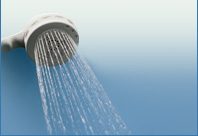
Showering is one of the biggest uses of water in the home, representing approximately 17 percent of residential indoor water use, or more than 1.2 trillion gallons of water consumed in the United States each year. In the future, to raise consumer awareness and improve the water efficiency of showerheads, WaterSense intends to develop a specification for labeling water-efficient showerheads.
Once the specification is finalized, manufacturers will be able to apply for the WaterSense label for their water-efficient showerheads. Consumers who want to save water but don't want a wimpy shower will just have to look for the WaterSense label to find showerheads that save water without sacrificing performance.
As with all WaterSense labeled products, these showerheads will be independently tested and certified to perform as well as or better than conventional models, while saving precious water.
Learn more about WaterSense's plans for water-efficient showerheads.
Why Don't You Visit More Often?
Been by lately? Explore WaterSense's updated water-saving tools on our Web site. We are busy maintaining and improving these resources to help you take water efficiency into your own hands. Check them out:



